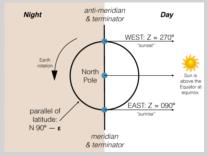
NavList:
A Community Devoted to the Preservation and Practice of Celestial Navigation and Other Methods of Traditional Wayfinding
From: Peter Hakel
Date: 2015 Nov 14, 01:48 +0000
For me it was helpful to visualize this arrangement as a helmet (Earth) with a central stripe (terminator), and a thin visor. At equinox the Sun is placed above one of the visor’s pivot points. The stripe is also your meridian and the visor’s arc points toward the Sun at all times, indicating Sun's azimuth. Your location is the intersection of the visor and the stripe. No matter how you tilt the visor, it remains perpendicular to the stripe. This is akin to observing the sunrise/sunset at equinox, in which case we have this perpendicularity at any latitude. Whether this right angle indicates azimuth of “East” or “West” depends on where the “North Pole” of that helmet is located along the stripe.
Peter Hakel
From: Jaap vd Heide <NoReply_JaapvdHeide@navlist.net>
To: pmh099@yahoo.com
Sent: Friday, November 13, 2015 2:36 PM
Subject: [NavList] Re: Graphically solving haversine calculation







